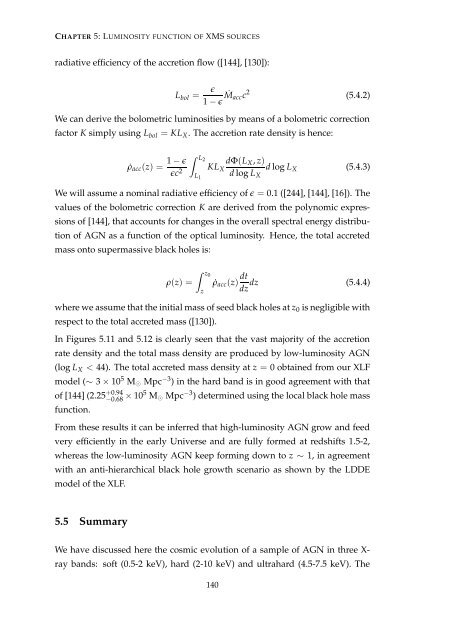pdf - SRON
pdf - SRON
pdf - SRON
Create successful ePaper yourself
Turn your PDF publications into a flip-book with our unique Google optimized e-Paper software.
CHAPTER 5: LUMINOSITY FUNCTION OF XMS SOURCES<br />
radiative efficiency of the accretion flow ([144], [130]):<br />
L bol =<br />
ɛ<br />
1 − ɛ Ṁaccc 2 (5.4.2)<br />
We can derive the bolometric luminosities by means of a bolometric correction<br />
factor K simply using L bol = KL X . The accretion rate density is hence:<br />
˙ρ acc (z) = 1 − ɛ<br />
ɛc 2<br />
∫ L2<br />
L 1<br />
KL X<br />
dΦ(L X , z)<br />
d log L X<br />
d log L X (5.4.3)<br />
We will assume a nominal radiative efficiency of ɛ = 0.1 ([244], [144], [16]). The<br />
values of the bolometric correction K are derived from the polynomic expressions<br />
of [144], that accounts for changes in the overall spectral energy distribution<br />
of AGN as a function of the optical luminosity. Hence, the total accreted<br />
mass onto supermassive black holes is:<br />
ρ(z) =<br />
∫ z0<br />
z<br />
˙ρ acc (z) dt dz (5.4.4)<br />
dz<br />
where we assume that the initial mass of seed black holes at z 0 is negligible with<br />
respect to the total accreted mass ([130]).<br />
In Figures 5.11 and 5.12 is clearly seen that the vast majority of the accretion<br />
rate density and the total mass density are produced by low-luminosity AGN<br />
(log L X < 44). The total accreted mass density at z = 0 obtained from our XLF<br />
model (∼ 3 × 10 5 M ⊙ Mpc −3 ) in the hard band is in good agreement with that<br />
of [144] (2.25 +0.94<br />
−0.68 × 105 M ⊙ Mpc −3 ) determined using the local black hole mass<br />
function.<br />
From these results it can be inferred that high-luminosity AGN grow and feed<br />
very efficiently in the early Universe and are fully formed at redshifts 1.5-2,<br />
whereas the low-luminosity AGN keep forming down to z ∼ 1, in agreement<br />
with an anti-hierarchical black hole growth scenario as shown by the LDDE<br />
model of the XLF.<br />
5.5 Summary<br />
We have discussed here the cosmic evolution of a sample of AGN in three X-<br />
ray bands: soft (0.5-2 keV), hard (2-10 keV) and ultrahard (4.5-7.5 keV). The<br />
140
















